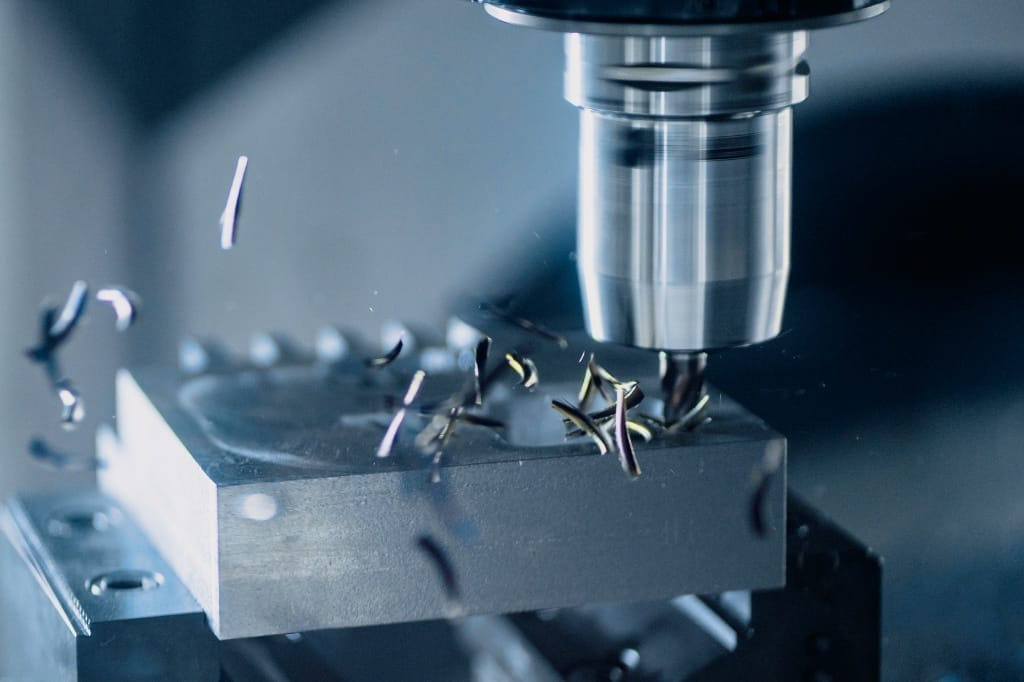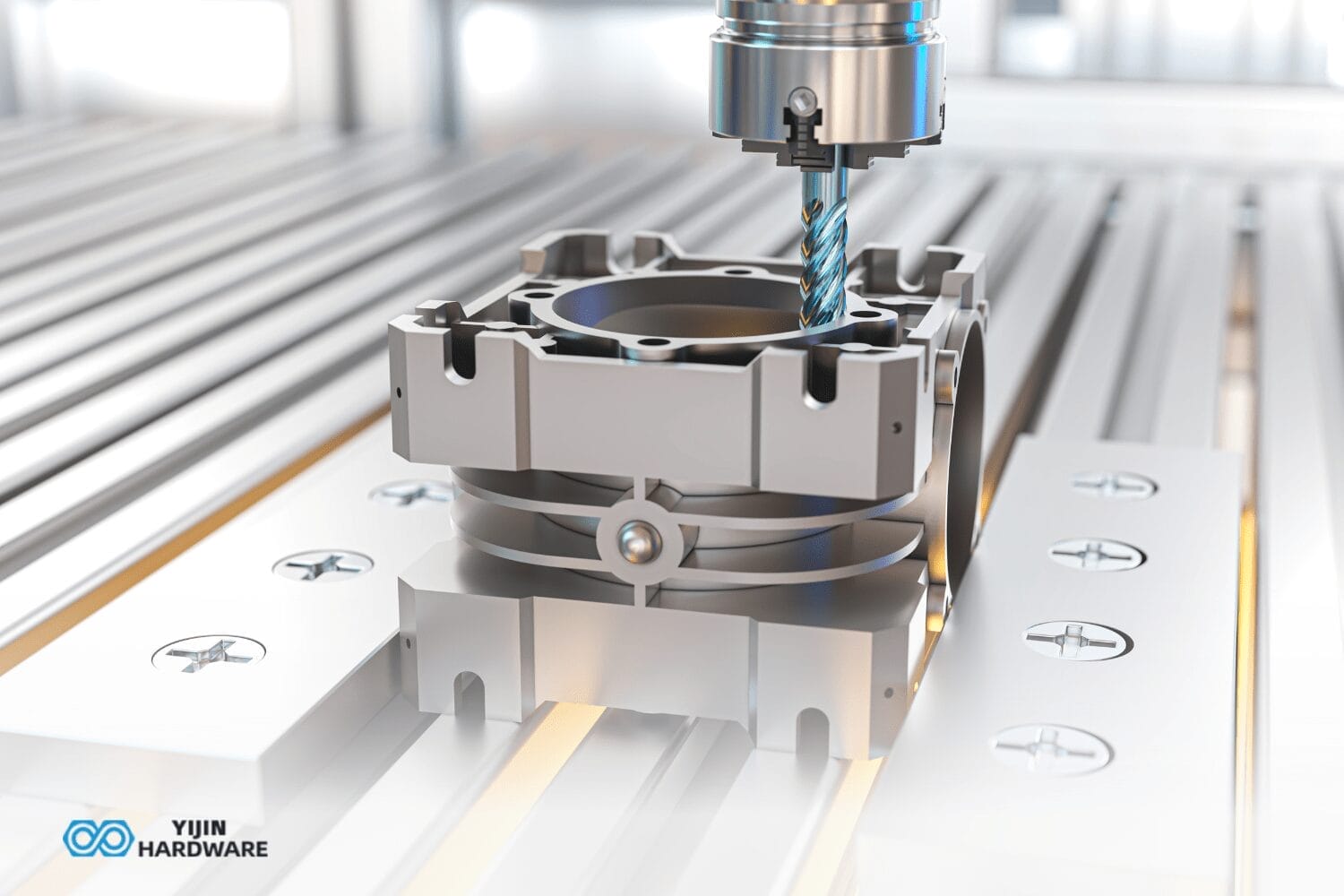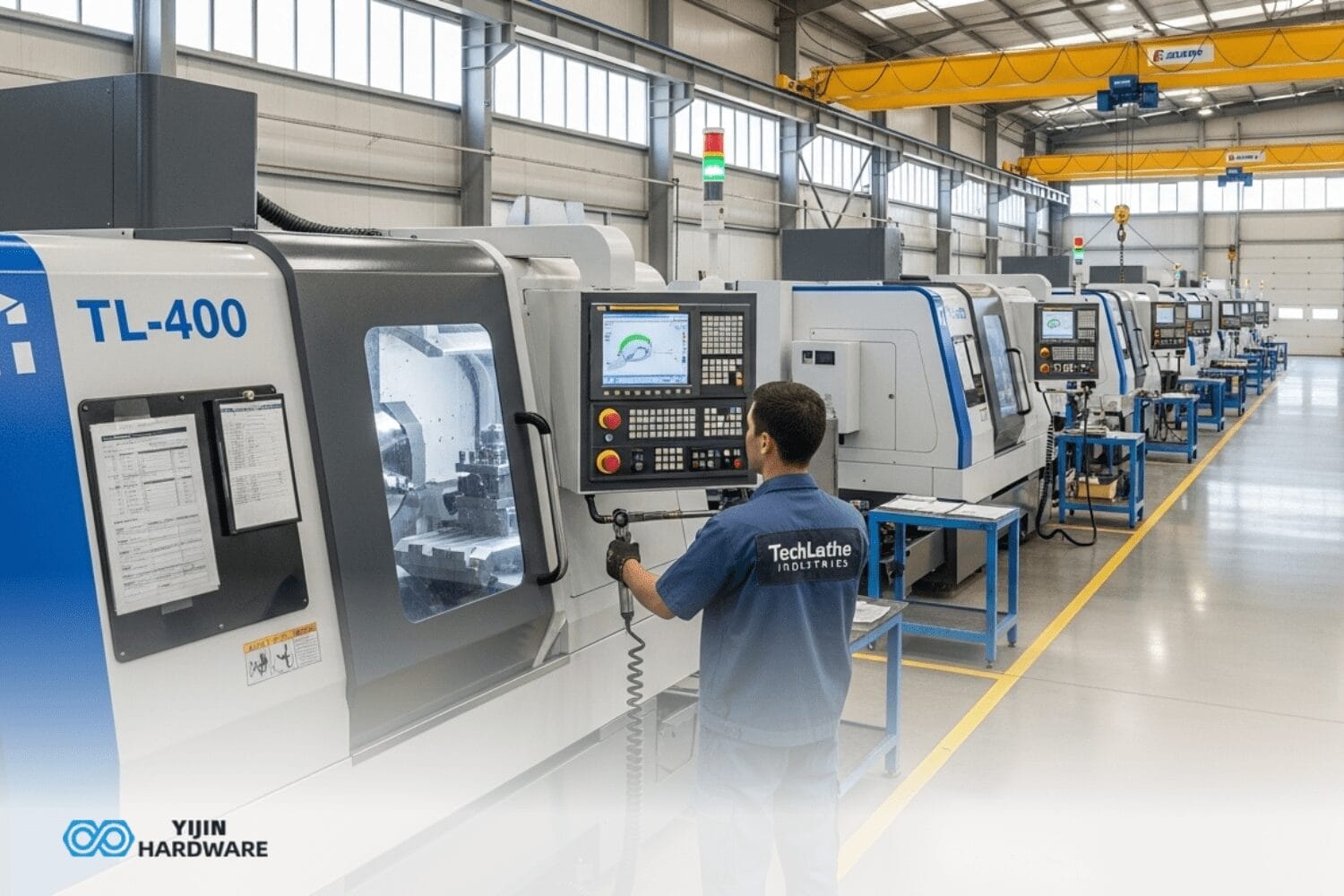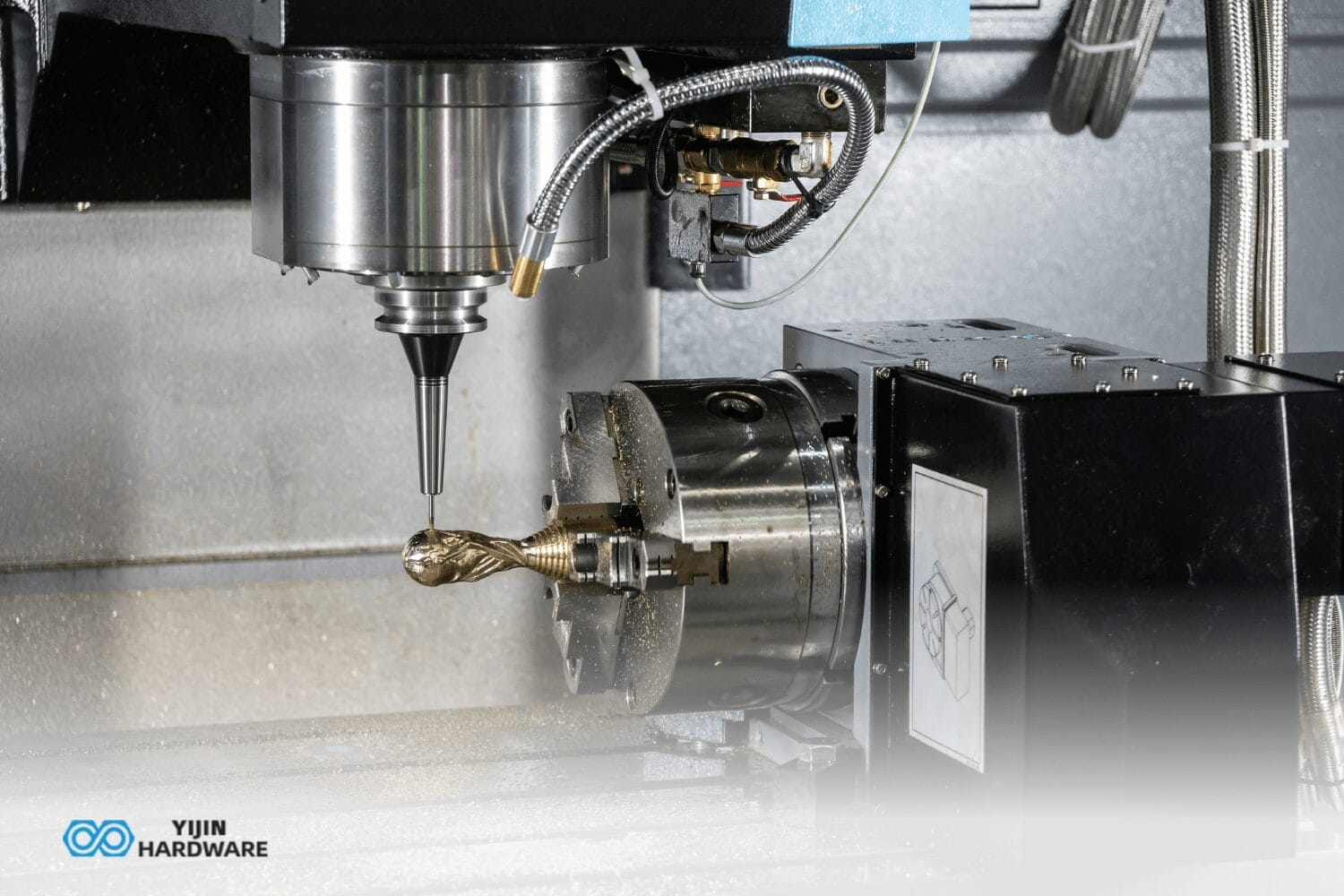CNC machining, or Computer Numerical Control machining, is a manufacturing process that uses computer technology to control machine tools. This method allows for precise cutting, shaping, and fabrication of materials — it is essential in various industries.
CNC machines automate the machining process, improving efficiency and accuracy compared to traditional manual methods. Yijin Hardware leverages CNC technology to deliver high-quality components tailored to specific needs.
Key Takeaways
- CNC machining uses computer technology to control machine tools for precise fabrication.
- The main types of CNC machines include milling machines, lathes, routers, and plasma cutters.
- CNC machines can perform various operations such as drilling, turning, and grinding.
- Automation in CNC machining enhances productivity and reduces human error.
- Yijin Hardware offers premium CNC machining China services, such as CNC milling China, tailored to diverse manufacturing needs.
What is CNC Machining?
CNC machining is a subtractive manufacturing process that removes material (substrate) from a workpiece to create the desired shape or design. Unlike conventional machining practices that rely heavily on manual operation, CNC machining employs computer programs to dictate the movement of machinery. This automation allows for high precision and repeatability in producing complex parts.
The CNC machining process begins with a digital design created using CAD (Computer-Aided Design) software. This design is then converted into a format that the CNC machine can understand through CAM (Computer-Aided Manufacturing) software. The machine executes the programmed instructions using various cutting tools to shape the material accurately. As a result, CNC machining is widely used in industries such as aerospace, automotive, and medical device manufacturing.
The CNC Machining Process

The CNC machining process consists of a few important steps, from initial design to quality control:
- Design Creation: Engineers create a detailed 3D model of the part using CAD software.
- Programming: The CAD model is converted into G-code through CAM software. This code contains instructions for the CNC machine on how to move and operate.
- Setup: The workpiece is securely mounted on the machine’s table or fixture. The appropriate cutting tools are selected based on the operations required.
- Machining Operations: The CNC machine executes the programmed commands, using various cutting tools such as drills, mills, or lathes to remove material from the workpiece.
- Quality Control: After machining, the finished part is inspected to ensure it meets specified tolerances and quality standards.
This systematic approach ensures that parts are produced efficiently and accurately while minimizing waste.
Types of CNC Machines
There are several types of CNC machines designed for different manufacturing processes and applications:
| CNC Machine Type | Description |
|---|---|
| CNC Milling Machine | Rotary-cutting tools remove material from a stationary workpiece; used for operations like drilling and boring |
| CNC Lathe | Rotates workpiece against stationary cutting tool for operations like turning and facing; ideal for cylindrical parts |
| CNC Router | Cuts softer materials like wood and plastics with a spinning router bit to carve intricate designs |
| CNC Plasma Cutter | High-temperature plasma arc cuts through conductive materials like steel and aluminum |
| CNC Laser Cutter | Focused laser beams for precision cutting of various materials, e.g., metals and plastics |
| EDM | Uses electrical discharges (sparks) to remove material from a workpiece — it’s ideal for creating complex shapes in hard materials |
These different types of CNC machines cater to various needs in the manufacturing industry, allowing for versatility in production capabilities.
Other Uses for CNC Machines
You might be wondering, “What can a CNC machine do?” Beyond traditional machining tasks, CNC machines have expanded their applications significantly:
- Prototyping: Rapid prototyping allows companies to create models quickly for testing before mass production.
- Fabrication: CNC machines are used in fabrication processes such as sheet metal working and custom part creation.
- Artistic Applications: Artists use CNC routers and laser cutters to create intricate designs in wood, metal, and acrylic.
- Medical Devices: Precision components for medical devices are often produced using CNC technology due to its accuracy.
- Aerospace Components: Complex parts required in aerospace applications benefit from the precision that CNC machining provides.
These diverse applications demonstrate the flexibility of CNC technology across various sectors.
CNC Machine Programming
Programming a CNC machine involves writing G-code that tells the machine how to move its tools and what operations to perform. This programming can be done manually or generated automatically through CAM software based on a CAD model. Key aspects of programming include defining:
- Tool paths
- Speeds and feeds
- Cutting depths
- Tool changes
Effective programming is crucial for optimizing machining operations, ensuring efficiency while maintaining high-quality standards in production.
Open/Closed-Loop Machining Systems
CNC systems can be classified into open-loop and closed-loop systems based on how they control machine movements:
- Open-Loop Systems: These systems send commands from the controller to the machine without feedback about the actual position of the tool. They are simpler but can be less accurate due to potential errors in movement.
- Closed-Loop Systems: These systems incorporate feedback mechanisms that continuously monitor the position of the tool during operation. This allows for real-time adjustments based on actual performance, resulting in higher accuracy and reliability.
Understanding these systems helps manufacturers choose the right setup based on their precision requirements.
The Benefits of CNC Machining
CNC machining offers benefits like unmatched precision, fast production, and reduced material waste, which makes it ideal for high-quality, complex designs. Its versatility, efficiency, and consistency are invaluable across industries like aerospace, automotive, and medical manufacturing.
Here are the key benefits of using a CNC machine tool or hiring a CNC service provider in detail:
| Benefit | Description |
|---|---|
| High Precision and Consistency | CNC machinery, including 5-axis CNC machines and spindle CNC grinders, delivers unmatched accuracy for intricate part production |
| Versatile Machining Operations | Supports a range of operations, e.g., CNC turning, CNC drilling, and CNC grinding, to shape workpieces to exact specifications |
| Improved Production Speed | The CNC process is automated, which accelerates production times without compromising quality; consequently, CNC machining is ideal for high-volume manufacturing |
| Reduced Material Waste | Minimizes waste by precisely targeting material removal |
| Support for Complex Designs | Advanced equipment like turning machines and CNC grinders enable the creation of complex shapes that are not feasible with manual machining |
| Wide Industry Application | Modern CNC manufacturing is essential in sectors that demand precision, with CNC machining operations used in CNC parts across automotive, aerospace, and medical industries |
| Consistency in Quality | Each machine works with programmed controls, maintaining uniform quality for every workpiece, and ensuring standards across large production runs |
Yijin Hardware: Affordable CNC Machining
Yijin Hardware is highly skilled in providing high-quality CNC machining services tailored to meet diverse manufacturing needs. With advanced machinery and skilled machinists, Yijin Hardware ensures precision in every project while maintaining efficient production timelines.
Whether you require prototyping or large-scale production runs, our expertise in various types of CNC machines guarantees exceptional results. Contact Yijin Hardware today to learn more about how we can assist with your next project!
FAQs on What is CNC Machining? Process, Types, and Applications
What are the applications of a CNC machine?
CNC machines are used in machining tasks across various industries, such as automotive, aerospace, and medical, to produce complex components. CNC machines work by employing equipment like a CNC lathe machine or 3-axis CNC to create precise parts used to cut metals, plastics, and more.
How many types of CNC operations are there?
There are several common types of CNC operations, including basic CNC turning, 4-axis CNC milling, and multi-axis CNC machining. The number of operations varies depending on the CNC machine type and its controller’s capabilities. CNC machinists often choose the CNC machine type that best suits the project requirements for efficient and accurate results.
Back to Top: What is CNC Machining? Process, Types, and Applications









